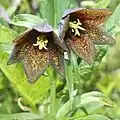| Fritillaria camschatcensis | |
|---|---|
 | |
| Scientific classification | |
| Kingdom: | Plantae |
| Clade: | Tracheophytes |
| Clade: | Angiosperms |
| Clade: | Monocots |
| Order: | Liliales |
| Family: | Liliaceae |
| Subfamily: | Lilioideae |
| Tribe: | Lilieae |
| Genus: | Fritillaria |
| Species: | F. camschatcensis |
| Binomial name | |
| Fritillaria camschatcensis | |
| Synonyms[1] | |
| |
Fritillaria camschatcensis is a species of flowering plant native to northeastern Asia and northwestern North America, including northern Oregon, Washington, British Columbia, Alaska, northern Japan, and the Russian Far East (Amur, Kamchatka, Khabarovsk, Magadan, Primorye, Sakhalin and the Kuril Islands).[2] It has many common names, including Kamchatka fritillary and Kamchatka lily.
It is also called rice lily, northern rice-root, or (misleadingly) Indian rice or wild rice, because of the rice-like bulblets that form around its roots.
Description
Fritillaria camschatcensis produces bulbs with several large fleshy scales, similar to those of commercially cultivated garlic. Leaves are lanceolate, up to 10 cm long, borne in whorls along the stem. Stem is up to 60 cm tall, with flowers at the top. Flowers are spreading or nodding (hanging downwards), dark greenish brown to brownish purple (chocolate colored),[3] sometimes mottled with yellow.[4][5][6][7] The flowers have a characteristic foul smell, and are pollinated by flies drawn to the offensive odor. [8]
See also
References
- ↑ The Plant List
- ↑ Kew World Checklist of Selected Plant Families
- ↑ https://www.fs.usda.gov/wildflowers/plant-of-the-week/fritillaria_camschatcensis.shtml
- ↑ Flora of North America v 26 p 168, Fritillaria camschatcensis
- ↑ Ker Gawler, John Bellenden. 1809. Botanical Magazine 30: sub pl. 1216, Fritillaria camschatcensis
- ↑ Linnaeus, Carl von. 1753. Species Plantarum 1: 303, as Lilium camschatcense
- ↑ Shimizu, Tatemi. 1983. New Alpine Flora of Japan in Color 2: 358, as Fritillaria camtschatcensis forma flavescens
- ↑ https://www.fs.usda.gov/wildflowers/plant-of-the-week/fritillaria_camschatcensis.shtml
External links
- USDA Plants Profile
- Photo of the Chocolate Lily
- European Garden Flora, Vol. 1
 an illustration showing the flower
an illustration showing the flower Flower
Flower Flowers in Mount Haku, Japan
Flowers in Mount Haku, Japan